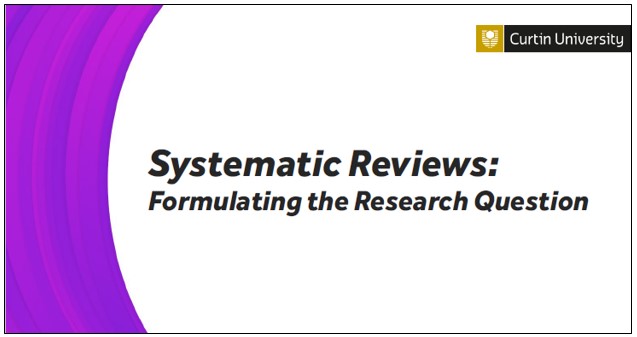Systematic & scoping reviews
Why use PICO?
Systematic reviews require focused clinical questions. PICO is a useful tool for formulating such questions. For information on PICO and other frameworks please see our tutorial below.
Systematic Reviews: Formulating the Research Question [PDF, 191kB]
This PowerPoint covers:
- Formulating the research question
- The PICO framework
- Types of questions
- Types of studies
- Qualitative questions
PICO example for quantitative studies
The PICO (Patient, Intervention, Comparison, Outcome) framework is commonly used to develop focused clinical questions for quantitative systematic reviews.
| Patient, Population or Problem | What are the characteristics of the patient or problem? What is the condition or disease you are interested in? |
| Intervention or exposure | What do you want to do with this patient (e.g. treat, diagnose, observe)? |
| Comparison | What is the alternative to the intervention (e.g. placebo, different drug, surgery)? |
| Outcome | What are the relevant outcomes (e.g. morbidity, death, complications)? |
Sample topic:
In middle aged women suffering migraines, is Botulinium toxin type A compared to placebo effective at decreasing migraine frequency?
P - Middle aged women suffering migraines
I - Botulinium toxin type A
C - Placebo
O - Decreased migraine frequency
Use the following worksheet to complete a search strategy:
PICo, SPICE or SPIDER example for qualitative studies
The PICO (Patient, Intervention, Comparison, Outcome) framework is commonly used to develop focused clinical questions for quantitative systematic reviews. A modified version, PICo, can be used for qualitative questions.
| Population | What are the characteristics of the patient or population? What is the condition or disease you are interested in? |
| Interest | What is the phenomena of interest? A defined event, activity, experience or process? |
| Context | What is the setting or distinct characteristics? |
Sample topic:
What are caregivers’ experiences with providing home-based care to patients with HIV/AIDS in Africa?
P - Caregivers providing home-based care to persons with HIV/AIDS
I - Experiences
Co - Africa
Use the following worksheet to create a search strategy:
The SPIDER framework is an alternative search strategy tool (based on PICo) for qualitative/mixed methods research.
| Sample | Who is the sample or population of interest? |
| Phenomenon of Interest | What is the phenomena of interest? A defined event, activity, experience or process? |
| Design | What types of study methods are you interested in? |
| Evaluation | What are the evaluation outcomes? (May be subjective - opinions, feelings etc.) |
| Research type | What type of research are you interested in? Qualitative or mixed method (qualitative & quantitative)? |
Sample topic:
What are the experiences of women undergoing IVF treatment?
S - Women
PI - IVF treatment
D - Questionnaire or survey or interview
E - Experiences or views or attitudes or feelings
R - Qualitative or mixed method
Cooke, A., Smith, D., & Booth, A. (2012). Beyond PICO: The SPIDER tool for qualitative evidence synthesis
Methley, A. M., Campbell, S., Chew-Graham, C., McNally, R., & Cheraghi-Sohi, S. (2014). PICO, PICOS and SPIDER: A comparison study of specificity and sensitivity in three search tools for qualitative systematic reviews
SPICE can be used for both qualitative and quantitative studies. SPICE stands for Setting (where?), Perspective (for whom?), Intervention (what?), Comparison (compared with what?) and Evaluation (with what result?).
Sample topic:
What are the coping skills of parents of children with autism undergoing behavioural therapy in schools?
S - Schools
P - Parents of children with autism
I - Behavioural therapy
C - None
E - Coping skills
Booth, A. (2006). Clear and present questions: Formulating questions for evidence based practice
